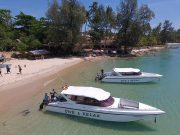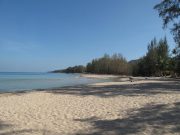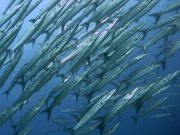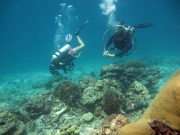Best Time to Visit Koh Lanta
The Best Time to Dive & Snorkel
The tropical island of Koh Lanta is located in the South Andaman Sea, close to the mainland province of Krabi in south west Thailand.
The island is just 7.6 degrees above the equator, and is relatively close to Malaysia and the Indonesian island of Sumatra.


A crucial part of planning a trip to Koh Lanta is understanding its weather and climate, when is the best time to visit the island, and what to expect from the weather and sea conditions.
The island's climate significantly impacts the experience, determining the best activities to enjoy, the accessibility of certain attractions, and the overall comfort during the stay.
Find out all about Koh Lanta, and how to get to Koh Lanta from Krabi, Ao Nang, Koh Jum, Phi Phi, Koh Lipe and Phuket.
Koh Lanta's Climate Overview
Koh Lanta, like much of southern Thailand, experiences a tropical monsoon climate characterised by two main seasons: the dry season and the rainy season. The island's weather is influenced by the southwest and northeast monsoons, leading to variations in temperature, humidity, and rainfall throughout the year.
- Dry Season (November to April):
- Temperature: During the dry season on Koh Lanta, temperatures range from 25°C to 34°C (77°F to 93°F). The weather is generally warm, with pleasant breezes that make it comfortable even during the hotter parts of the day.
- Rainfall: Rainfall is minimal during these months, with clear skies and abundant sunshine. January and February are the driest months, often with no significant rain at all. Perfect for scuba diving and snorkelling.
- Humidity: The humidity levels are moderate, making it easier for visitors to engage in outdoor activities without feeling overly uncomfortable.
- Winds: The winds during this season are gentle, mainly coming from the northeast, making the seas calm and ideal for water activities.
- Rainy Season (May to October):
- Temperature: The rainy season on Lanta brings slightly cooler temperatures, typically ranging between 24°C to 32°C (75°F to 90°F). However, the high humidity can make it feel warmer than it is.
- Rainfall: This season is characterised by frequent rain showers, especially in the afternoons and evenings. September and October are the wettest months, with heavy downpours that can last for hours.
- Humidity: Humidity levels are high during the rainy season, often reaching up to 90%, creating a muggy atmosphere.
- Winds: The southwest monsoon brings stronger winds, particularly from June to August. These winds can make the sea rough, leading to less favourable conditions for water-based activities and sometimes causing ferry services to be suspended.
Month-by-Month Koh Lanta Weather Breakdown
Every season is different, but here we try to give a rough idea of what to expect in a typical season.
- October:
- Weather: October is the tail end of the rainy season, with decreasing rainfall and occasional sunny days. The temperatures start to rise again as Koh Lanta prepares for the dry season.
- Activities: As the month progresses, conditions improve for beach activities and exploring the island. Diving conditions are improving and we usually have plenty of days with excellent weather. Start of the diving season, with usually good visibility.
- November:
- Weather: November marks the beginning of the dry season, with decreasing rainfall and increasing sunshine. Temperatures are warm, and the humidity starts to drop.
- Activities: Ideal for beach activities, exploring the island, and beginning of the peak tourist season. Diving conditions are usually good, with reasonable visibility.
- December:
- Weather: December is a popular time for tourists, with clear skies, low humidity, and perfect beach weather. Temperatures are comfortable, and the island is buzzing with visitors.
- Activities: Great for snorkelling, diving, and enjoying the holiday season festivities.
- January:
- Weather: January continues the trend of excellent weather with minimal rainfall, cool breezes, and warm temperatures. It is one of the best months to visit Koh Lanta.
- Activities: Ideal for outdoor exploration, diving, snorkelling, island-hopping, and sunbathing.
- February:
- Weather: February is another peak month with fantastic weather. The temperatures are slightly higher than in January, but the conditions remain ideal.
- Activities: Perfect for beach days, diving, and experiencing local culture.
- March:
- Weather: March sees a gradual increase in temperatures, with occasional short showers. The sea remains calm, and the weather is still favourable for most activities.
- Activities: Great for diving, exploring national parks, and enjoying the last of the high season.
- April:
- Weather: April is one of the hottest months on Koh Lanta, with temperatures often reaching up to 34°C (93°F). The humidity starts to rise, and brief rain showers become more common.
- Activities: A good time for beach activities, but visitors should be prepared for the heat. The Songkran festival in mid-April offers a unique cultural experience. Great diving conditions.
- May:
- Weather: May marks the transition to the rainy season. Rainfall becomes more frequent, and the temperatures start to drop slightly. The sea may become rougher.
- Activities: While the weather is less predictable, this is a quieter time to visit, with fewer tourists and still a great time to go diving. It’s a good month for those looking for a more peaceful experience.
- June:
- Weather: June is fully into the rainy season on Koh Lanta, with regular showers and overcast skies. The temperatures remain warm, but the humidity is high.
- Activities: Limited outdoor activities due to rain, but still good for visiting local markets and indoor experiences.
- July:
- Weather: July continues with similar weather patterns as June, with frequent rain and high humidity. However, there can still be some sunny days in between showers.
- Activities: Best for indoor activities, relaxation, and enjoying the island’s greenery, which is lush during this time.
- August:
- Weather: August sees some of the heaviest rains of the year, with thunderstorms not uncommon. The sea is often rough, and many boat services are limited.
- Activities: Mainly indoor activities, exploring the island’s natural beauty, and enjoying a quiet retreat.
- September:
- Weather: September is typically the wettest month on Koh Lanta, with heavy rains, high humidity, and occasional storms. The sea is typically too rough for swimming or water activities.
- Activities: Not the best time for outdoor activities, but it can be a good time to enjoy the tranquil atmosphere and off-season prices.
Temperature vs Humidity
Early morning temperatures on Koh Lanta vary from a chilly 24 degrees in December/January, to 28 degrees in July/August.
The afternoon highs vary from around 28 - 30 in December/January, through to 32 - 34 degrees in April to August.
What really makes a difference in the ‘real feel’ temperature is the higher humidity starting in March through to September.
March, April, and May can often feel like the hottest months of the year due to the very high humidity, but it’s also when we can have some of the best diving conditions.
When Is The Best Time To Visit Koh Lanta?
The Koh Lanta diving season is generally the high season months from late October to early May. The wind is mostly from the east, blowing through the South China Sea into the Gulf of Thailand.
The Thai-Malay Peninsula acts as a wind buffer and here on Koh Lanta we usually experience extended periods of sunny days with flat calm seas and little or no rain.
Despite the often great high season weather, we can however occasionally have localised afternoon thunderstorms, with winds sometimes being stronger or changing direction for short periods.
During periods of stronger winds, which can occasionally last for a few days, we may need to change our dive trip schedules.
- November to February:
- Why Visit: These months are particularly ideal for a visit. The weather is at its best, with minimal rainfall, moderate humidity, and comfortable temperatures. The sea is calm, perfect for snorkeling, diving, and boat tours. The island is also lively, with various festivals and events taking place.
- March to April:
- Why Visit: While the temperatures are higher, these months still offer excellent weather for outdoor activities, and some of the best diving conditions of the high season. April, in particular, is a great time to experience the Songkran festival, Thailand’s traditional New Year celebration, which includes water fights and cultural events across the island.
- May to October:
- Why Visit: Although this is the rainy season, there are still reasons to visit during these months. The island is much quieter, with fewer tourists and lower prices for accommodation and activities. The diving is still good, and the landscape is lush and green, providing a different kind of beauty. However, visitors should be prepared for rain and potentially rough seas, which can limit some activities.
Koh Lanta's Wet Season
During the typical rainy season months of June to end of September, the westerly monsoon winds from the Indian Ocean bring periods of rain and the occasional storms, however Koh Lanta can also experience long periods of sunshine and calm seas throughout the summer months.
The wettest weather is traditionally in June and September.
Unfortunately the monsoon winds that control Koh Lanta's weather do not change direction on time every year. This means that the rainy season can start later in June, with a break for several months of fine weather and then sometimes start again at the beginning of 'high season' to continue well into January.
Koh Lanta Diving Conditions
Diving conditions vary throughout the year, the best conditions typically being October to early May, though of course the weather can be unpredictable at any time.


Occasionally we can have a few days of stormy weather at some point during the high season months.
Diving during the low season is possible, with the best conditions likely between early July and late August.
Water Temperature @ Koh Lanta's Dive Sites
The sea water temperature at most dive sites varies from 28 - 31 degrees throughout the year.
Generally the cooler months are November, December and January, with the hottest and most humid months typically being March and April.
Thermoclines can occasionally drift past, bringing a 'chilly' 26 - 27 degrees for a few minutes underwater. Sometimes we can find less common marine life species in bodies of cooler water.
Best Wetsuit for Koh Lanta Diving
Since the sea water temperatures are typically 28 - 31 degrees, a 3mm shorty wetsuit is suitable for most people.
If you’re feeling a bit cold after the first dive then we can provide 2 shorty wet suits to be worn on top of each other, or if you prefer, you can bring your own full length wetsuit.
Some people feel the cold quite strongly, and in this case we recommend that you bring your own 3/4/5 mm full length wetsuit in order to avoid any ‘chilly’ moments underwater.
Visibility @ Koh Lanta's Dive Sites
Visibility varies throughout the year, ranging from 5 - 10m on Koh Phi Phi after stormy weather to 30m+ at Koh Haa and Koh Bida during periods of fine weather.
Currents can bring plankton at any time of year which reduces visibility and makes the water more greenish and this provides food for larger sea creatures.
Plankton is important because (for example) we are more likely to see manta ray at Hin Daeng & Hin Muang with greenish water and slight currents than with blue water and 40m+ visibility. Thermoclines can appear at any time and can also affect visibility.
Koh Lanta Weather Forecast
Please remember that the above is only a rough guide based on our observations over the past years, and El Nino seasons can mean hotter and drier weather, whilst La Nina seasons can mean cooler, windier, and wetter weather.
Our weather, sea conditions, and diving conditions are also affected by the Indian Ocean Dipole.
We don't pretend to be able to forecast the weather and often the weather forecast is wrong (please do not ask us to predict the weather in advance of your trip to Koh Lanta!).
For those of you looking for more information, there are many weather resources on the internet to help with your planning:


